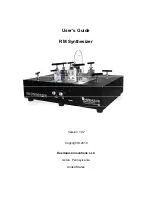
ABOUT ANALOGUE SYNTHESIS
Below is a diagram showing the signal path in the Supernova II Rack & all the waveforms at various locations.
Different waveforms are being produced by different oscillators using different techniques. The Oscillators, Ring Modulators & the
Noise Generator all being Mixed together & feed to the filter. The signal is then in turn fed to the Amplifier. Oscillator 1 is using a
Square wave modulated by Sync Skew & then Hardened to create a sine-like wave except it has an extra bump in it. This pro-
duces a Whistle like sound. Oscillator 2 is using a Saw wave modulated by Sync Skew & Sync producing a Harsh sound &
Oscillator 3 is using a Square wave modulated by Sync Skew & Formant Width to produce a bright PWM like waveform. The 1*3
Ring modulator & the 2*3 Ring modulator are producing complex waveforms & these along with all the Oscillators & the Noise gen-
erator are fed to the Mixer.
FILTER - tone
There are several different types of filter. These are Low Pass Filter, High Pass Filter & Band Pass Filter.
The Low Pass Filter allows harmonics below a set frequency to pass through the filter. Hence the name Low Pass Filter.
The High Pass Filter allows harmonics above a set frequency to pass through the filter. Hence the name High Pass Filter. The
Band Pass Filter allows harmonics at a set frequency to pass through the filter, the harmonics above & below the set frequency do
not pass through the filter. Hence the name Band Pass Filter. Below are the frequency response curves of the three types of filters.
Additionally the slope of the curve at which the filter rejects unwanted harmonics can be altered. The effect is similar to a “Q” con-
trol on a parametric EQ. In the 12db position the Cutoff Frequency slope is less steep so the higher frequencies are not attenuated
as much as they are in the 24 or 18db positions. This makes the resulting filtering in the 12db position more subtle than the 24 or
18db positions which you should select if you want the Cutoff Frequency to be more obvious. The slope is measured in db per
Octave & below are the response curves of a Low Pass Filter with 24, 18 & 12 db per Octave slopes.
All these filters have a Resonance parameter. This has the effect of emphasising harmonics at the cutoff frequency of the filter.
This is very useful for creating large tonal differences to a basic waveform. The effect is shown below as both frequency response
curves when resonance is applied in a the Filter.
Frequency
Volume
12db/oct LPF Responce Curve
Cutoff
Frequency
Frequency
Volume
18db/oct LPF Responce Curve
Cutoff
Frequency
Frequency
Volume
24db/oct LPF Responce Curve
Cutoff
Frequency
Frequency
Volume
Band Pass Filter Responce Curve
Cutoff
Frequency
Frequency
Volume
High Pass Filter Responce Curve
Cutoff
Frequency
Frequency
Volume
Low Pass Filter Responce Curve
Cutoff
Frequency
MIXER
Osc 1 level
Osc 1*3 level
Osc 2 level
Osc 2*3 level
Noise level
Osc 3 level
Osc 1*3
Ring Mod
Osc 2*3
Ring Mod
Ring Mod output
Ring Mod output
Osc 1 output
( Sq wave Softened with
+ve Skew )
Osc 2 output
( Saw wave Synced with
+ve Skew )
Osc 3 output
( Sq wave Synced with
+ve Skew & Formant width )
Pink noise output
Osc 1
Osc 2
Osc 3
Noise
Gen
Signal Path Diagram
Filter
Amp
Env 1
Env 2
Env 3
LFO 1
LFO 2
Mixer output
Filter output
Amp output
10
Summary of Contents for Supernova II
Page 145: ...145 NOTES...







































